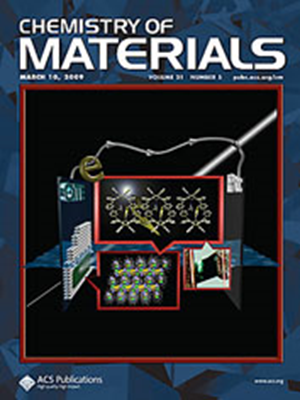LiI-Modified Glass-Ceramic Lithium Thioborate: From Fundamentals to Applications in Solid-State Batteries
IF 7.2
2区 材料科学
Q2 CHEMISTRY, PHYSICAL
引用次数: 0
Abstract
Solid-state batteries are an emerging battery technology rivaling lithium-ion batteries, but before commercialization can occur, new classes of solid-state electrolytes (SSEs) must be investigated to better understand the fundamental properties of these materials and to extend the capabilities of fast charging and cycle life. In this work, we investigate glass-ceramic lithium thioborate (LBS) SSEs with the stoichiometry of Li10B10S20 and utilize a rapid synthesis that enables lithium iodide (LiI) modification in Li10B10S20. We study the structures of four materials with varying amounts of LiI using X-ray diffraction, pair distribution function, and solid-state NMR and find that LiI breaks down the B10S20 supertetrahedra that make up the unit cell of Li10B10S20. More LiI increases ionic conductivity by increasing the unit cell volume and the fraction of the glassy phase in the electrolyte. LiI-modified Li10B10S20 as an anode-facing SSE enables all-solid-state batteries to cycle well with theoretical capacities up 6.37 mAh/cm2 at 0.1C, validating the relevance of LBS SSEs as separators for solid-state batteries.

固态电池是一种新兴的电池技术,可与锂离子电池相媲美,但在实现商业化之前,必须对新型固态电解质(SSE)进行研究,以便更好地了解这些材料的基本特性,并延长其快速充电能力和循环寿命。在这项工作中,我们研究了化学计量学为 Li10B10S20 的玻璃陶瓷硫代硼酸锂(LBS)固态电解质,并利用快速合成技术在 Li10B10S20 中实现了碘化锂(LiI)修饰。我们利用 X 射线衍射、配对分布函数和固态核磁共振研究了四种含有不同数量 LiI 的材料的结构,发现 LiI 会破坏构成 Li10B10S20 单胞的 B10S20 超四面体。更多的 LiI 会增加电解质中的单胞体积和玻璃相比例,从而提高离子电导率。经 LiI 修饰的 Li10B10S20 作为面向阳极的固态电子元件,可使全固态电池在 0.1C 时循环良好,理论容量高达 6.37 mAh/cm2,从而验证了 LBS 固态电子元件作为固态电池隔膜的相关性。
本文章由计算机程序翻译,如有差异,请以英文原文为准。
求助全文
约1分钟内获得全文
求助全文
来源期刊

Chemistry of Materials
工程技术-材料科学:综合
CiteScore
14.10
自引率
5.80%
发文量
929
审稿时长
1.5 months
期刊介绍:
The journal Chemistry of Materials focuses on publishing original research at the intersection of materials science and chemistry. The studies published in the journal involve chemistry as a prominent component and explore topics such as the design, synthesis, characterization, processing, understanding, and application of functional or potentially functional materials. The journal covers various areas of interest, including inorganic and organic solid-state chemistry, nanomaterials, biomaterials, thin films and polymers, and composite/hybrid materials. The journal particularly seeks papers that highlight the creation or development of innovative materials with novel optical, electrical, magnetic, catalytic, or mechanical properties. It is essential that manuscripts on these topics have a primary focus on the chemistry of materials and represent a significant advancement compared to prior research. Before external reviews are sought, submitted manuscripts undergo a review process by a minimum of two editors to ensure their appropriateness for the journal and the presence of sufficient evidence of a significant advance that will be of broad interest to the materials chemistry community.
 求助内容:
求助内容: 应助结果提醒方式:
应助结果提醒方式:


